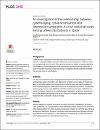An investigation of the relationship between cyberbullying, cybervictimization and depression symptoms: A cross sectional study among university students in Qatar
| Author | Alrajeh, Sara Mohamed |
| Author | Hassan, Huda Mohammed |
| Author | Al-Ahmed, Aisha Salim |
| Author | Hassan, Diana Alsayed |
| Available date | 2022-01-12T11:04:40Z |
| Publication Date | 2021-12-01 |
| Publication Name | PLoS ONE |
| Identifier | http://dx.doi.org/10.1371/journal.pone.0260263 |
| Citation | Alrajeh SM, Hassan HM, Al-Ahmed AS, Alsayed Hassan D (2021) An investigation of the relationship between cyberbullying, cybervictimization and depression symptoms: A cross sectional study among university students in Qatar. PLOS ONE 16(12): e0260263. https://doi.org/10.1371/journal.pone.0260263 |
| Abstract | Background Cyberbullying is a modern form of bullying that could be practiced electronically or on the internet. It is related to different mental health issues such as depression, which can affect both the cyberbully and the victim. Although a few studies have been conducted regarding the prevalence of cyberbullying and cyber-victimization among the younger generation in Qatar, no studies have been conducted among young adults despite studies showing that they are also prone to cyberbullying. Methods This is a cross-sectional study to investigate the prevalence and the relationship between cyberbullying, cyber-victimization, and depression symptoms among Qatar University students. A self-administered close-ended electronic questionnaire was used to assess student's cyberbullying/cyber-victimization behaviors and depression symptoms. The Revised Cyberbullying Inventory scale (RCBI-II) and Patient Health questionnaire-9 (PHQ-9) were utilized to measure involvement in cyberbullying and depression symptoms, respectively. A total of 836 students participated in the study. Pearson Chi-Square test and binary logistic regression were conducted to analyze the data. Results Results indicated the majority of students have been involved in cyberbullying as follows: 6.8% cyberbullies, 29.2% cybervictims, 35.8% cyberbully-victims, and 28.2% not involved in either. Approximately 50% of the students scored a ten or higher on the PHQ9 test indicating symptoms of depression. Moreover, significant associations were found between cyberbullying experiences and gender (p = 0.03), depression and gender (p = 0.046), and between cyberbullying experiences and depression (p<0.001). Conclusion Our findings indicate that among Qatar University students, cyberbullying and cyber-victimization are prevalent behaviors that could be associated with the high reported rates of depression symptoms. |
| Language | en |
| Publisher | Public Library of Science |
| Subject | Adolescent Adult Crime Victims/psychology Cross-Sectional Studies Young Adult |
| Type | Article |
| Issue Number | 12 |
| Volume Number | 16 |
| ESSN | 1932-6203 |
Files in this item
This item appears in the following Collection(s)
-
Public Health [514 items ]


